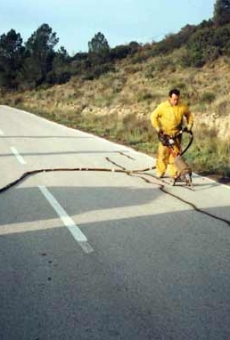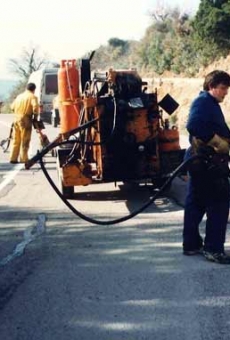Whenever the asphalt is worn off or showing premature failures, it begins to develop cracks within its structure that, over time, reach the surface. When a wheel runs over an existing crack on the pavement, the lower shear stress in the upper asphalt layer,and it ends up breaking the asphalt,in whose surface a reflection crack appears. This crack allows the intrusion of water and waste product,whichcause a surface degradation that affectsthe uniformity of the surface (and therefore, comfort and traffic safety) and causes a decrease in the capacity of the lower layers; this reducessignificantly the life of the pavement.
Cracks on asphalt mixes which are produced byshrinkage in layers based on hydraulic binders,by surfaces’ weariness, by sinking in landfills or by transverse-longitudinal joints produced when spreading asphalt, are sealed with a hot bituminous mastic obtained from an elastomer-modified bitumen COMPOFIX type.This allows the watertightnes and avoids further development of cracks, degradation of the surface and damages to lower layers.
What is Rhinophalt?
Rhinophalt material conservation is a low-cost fortified Gilsonite. It has been shown that surface treatment use as extends the life of the treated surfaces for a significant number of years.
Rhinophalt is especially effective as part of a preventive maintenance regime. Its application in the early years of the paving ensures optimal conservation and reduced maintenance costs results.
What are the benefits of the Rhinophalt ?
Traditional systems of bituminous pavements are one of the biggest costs associated with the road network . Demonstrated ability Rhinophalt to prevent deterioration of this infrastructure significantly extends the life of bituminous pavements , generating social, financial and environmental benefits over conventional methods:
Reduction by 90 % of interruptions in road traffic .
88% reduction of CO2 emissions
Reduction by 50 % of the costs of maintenance .
Rhinophalt every 5 years can be applied onto the bituminous surfacings without affecting the shear strength or texture depth milling is not necessary and the existing pavement. Moreover, as compound impregnated preservation Rhinophalt effectively becomes part of the bituminous material in the pavement , thus eliminating any problems of delamination .
USES
Roads and highways
Runways and taxiways
Parking
Docks and harbors
Andenes
bike lane
pedestrian zones




